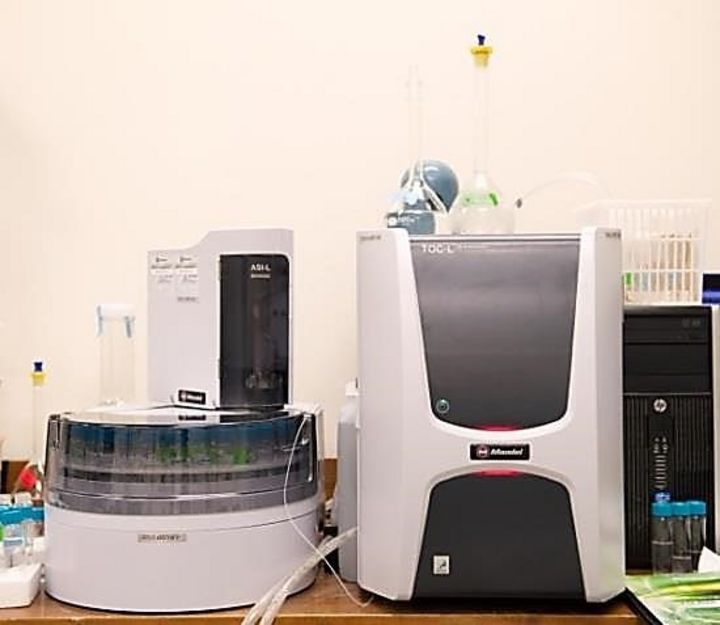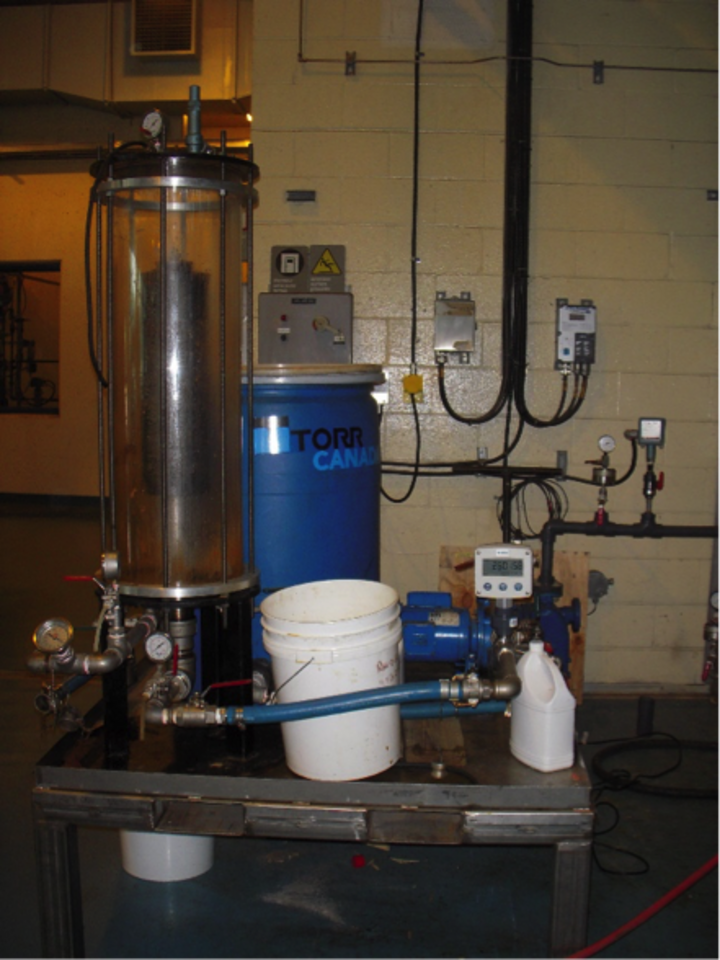Pilot for the treatment of industrial wastewater containing volatile compounds, for both pedagogy and research and development. It is a flexible equipment that allows feasibility studies on different types of contaminated water. It is composed of :
- 10 l capacity polyethylene feed tank with removable lid
- Total drain valve at the bottom of the tank
- Raw water supply valve
- Variable flow centrifugal feed pump
- Supply pipe at the top of the PVC column
- Control valve and flowmeter on filter supply
- A filtration column on the air stripping bench and modifications on the bench to accept this filtration column

- Atomic absorption spectrophotometer (flame and graphite furnace)
- Automated titrator and Karl Fisher
- Capillary electrophoresis
- Differential Scanning Calorimeter (DSC)
- Fluorescence Spectrometer X (XRF)
- FTIR infrared spectrometer with cell specialized in gas and biogas analysis
- Fluorimeter
- Gas chromatograph (GC-TCD) for gas analysis
- Gas chromatograph (GC-FID)
- FTIR Infra-Red Spectrometer For Solid And Liquid Samples
- Ion chromatography
- Gas chromatograph combined with a mass spectrometer (GC-MS)
- High-performance liquid chromatography combined with an ion-trap mass spectrometry (LC-MS)
- High-Performance Liquid Chromatography (2 Units, One Of Which Is Equipped With A Fraction Collector)
- High-Performance Liquid Chromatograph With An ELSD Detector (Electrospray Light Scattering Detector)
- Kjeldahl analyzer (total nitrogen and ammonia)
- Spectromètre d’émission optique muni d’un plasma à couplage inductif (ICP-OES)
- Thermogravimetric analyzer coupled with mass spectrometer (TGA-MS)
- Total organic carbon analyzer
The Aquatic Bio-optics and Biogeochemistry Laboratory enables researchers to study the effects of climate change and permafrost thawing on lake water transparency and mixing dynamics and their multiple impacts on the microbial food chain, greenhouse gas emissions, and oxythermal habitat. Research at the Aquatic Bio-Optics and Biogeochemistry Laboratory also focuses on developing optical equipment for early detection of algal and cyanobacterial blooms and other problems related to water browning.
- Gas chromatography and mass spectrometry
- Ion chromatography
- Atomic absorption spectrometry with flame
- Zetameter
- Infrared spectroscopy
- Total organic carbon analyzer
- High performance liquid chromatography
- UV-Visible spectrophotometer
- Solid phase extraction equipment for hydrocarbons
- Basic analytical equipment
- Oil & grease analyzer
- Activated carbon adsorption column
- Column for aeration tests
- Respirometer

/// Description :
- A 55 L / min, 15 psig capacity coalescing separation vessel, SS316 stainless steel and acrylic construction with internal support for TORR ™ coalescing cartridge and safety valve
- A centrifugal type electric water pump, 220 VAC, 15 amp
- A 200-liter plastic back-up tank with removable cover for storing and recirculating water
- Set of 1 '' industrial piping, flexible for interconnection of the various elements of the system
- Set of valves for component isolation and for pump flow control
- Pressure gauges at the entry and exit of the vessel
- A 48 '' x 48 '' stainless steel table with retention walls in the event of a system leak on which all system components rest
- 10 sealing washers for replacement
- Made and assembled in Quebec
- Works with TORR ™ coalescing cartridges. Model TC-008-2, 6 '' diam x 20 '' high, nylon and nitrile gaskets
Confocal microscopy and flow cytometry laboratoryThe laboratory is equipped with a four-laser LSRFortessa cytometer that allows high-level multiparametric analyzes to characterize cell populations. A BD FACS Calibur two-laser cytometer is used to perform routine analyzes such as the expression of surface markers. The Zeiss LSM780 confocal microscopy system is a state-of-the-art instrument for the study of various cellular and subcellular biological processes such as intracellular trafficking and localization of pathogen molecules.
The Yargeau Laboratory of Controlling Contaminants of Concern is located at McGill University and is funded by the Canada Foundation for Innovation (CFI) and the Natural Sciences and Engineering Research Council of Canada (NSERC). This state-of-the-art laboratory is the solution to any research need related to the presence, fate, and removal of contaminants in the wastewater treatment process. Equipements include: LC-HRMS ; Microtox; Accelerated solvent extraction system; Microwave extraction system; solide phase extraction.
The Laboratory for Ecotoxicogenomics and Endocrine Disruption (LEPE) brings together the expertise, knowledge, infrastructure and instrumentation necessary to test the effects of contaminants on the health of living organisms. The experiments are carried out in the laboratory, in microcosm, in mesocosm and in the field. The team is developing unique biomarkers for each target species in order to understand and validate the mechanisms of action of contaminants. The group also specializes in the study of endocrine disruptors and has, among other things, ultra-sensitive cell lines that identify contaminants capable of altering the hormonal response.
This pilot laboratory provides the scientific community and industry with its multidisciplinary expertise and state-of-the-art equipment for the development and scaling of fermentation processes as well as the recovery, purification and characterization of various microbial derivatives. Its primary purpose is R & D in the field of biotechnology, and especially value-added products using putrescible residues as raw material.
The researchers at the Environmental Engineering Laboratory are tasked with acquiring knowledge to improve the quality of the environment. In particular, they work in two major areas of research, namely the development of innovative environmental technologies for the rehabilitation of contaminated environments, and the characterization of contaminated environments.